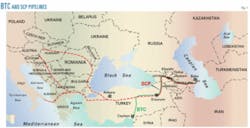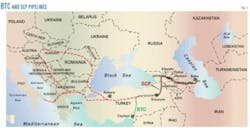Azerbaijan soon will become a major energy exporter. Officials opened the valves to start line fill late last month at the Sangachal terminal near Baku on the Baku-Tbilisi-Ceyhan (BTC) Pipeline, which will move crude oil from Azerbaijan’s Caspian Sea region to western markets. BP PLC operates the new line.
Underlining the economic importance of the event, the pipeline was inaugurated by Pres. Ilham Aliyev of Azerbaijan, Pres. Ahmet Sezer of Turkey, and Pres. Mikhail Saakashvilli of Georgia. Also in attendance was Kazakhstan’s Pres. Nursaltan Nazarbayev.
Line fill will take 10 million bbl and about 4 months to complete. Cost of the project is somewhere between $4 billion and $5.24 billion.
The 1,100-mile BTC Pipeline stretches from the Sangachal terminal south of Baku, capital of Azerbaijan, through Tbilisi, capital of Georgia, to Ceyhan, Turkey, on the Mediterranean Sea coast. At capacity, it could transport about 1 million b/d. Poten & Partners, New York, says a new terminal near completion at Ceyhan will have seven new crude oil storage tanks and a jetty that can load two tankers up to 300,000 dwt simultaneously.1
First tanker loading at Ceyhan is expected in the fourth quarter this year. Construction on the pipeline started in May 2003. At the peak of construction in fall 2004, 23,000 people were employed on the BTC project.
The crude oil comes from first-phase development of the Azeri Chirag and Gunashli fields in the Azerbaijan sector of the Caspian Sea. According to BP, these fields have estimated reserves of more than 4.5 billion bbl. The fields, however, won’t be fully on stream until 2008.
In the meantime, Kazakhstan would also like to benefit from the new pipeline, and an agreement was signed May 24 to give it access to BTC. Kazakhstan expects to produce 150 million tonnes/year of oil by 2015 and it could use the pipeline after Aktau, its port city, is connected to Baku. The addition of Kazakh oil would help the profitability of BTC, especially before the Azeri Chirag and Gunashli fields are producing at capacity around 2008.
Most crude shipped through the pipeline is expected to come from the Azeri fields for about 10 years. After 2015, officials expect crude from Kazakhstan’s offshore Kashagan field to dominate (OGJ, Apr. 19, 2002, p. 40).
The project’s biggest economic benefits will go to Azerbaijan because the pipeline will serve mainly as a conduit for the above-mentioned oil fields (OGJ Online, May 25, 2005). With oil at $25/bbl, the government could earn $50 billion over 20 years. Georgia and Turkey will earn about $600 million and $2.5 billion, respectively, mainly from transit fees.
BP leads the consortium in the BTC project with 30.1% interest. Other owners include State Oil Co. of Azerbaijan (SOCAR), 25%; Unocal, 8.9%; Statoil, 8.71%; Turkey’s state oil company, TPAO, 6.53%; Eni, 5%; Total, 5%; Japan’s ITOCHU Oil Exploration (BTC) Inc., 3.4%; Japan’s INPEX BTC Pipelines Ltd., 2.5%; ConocoPhillips Inc., 2.5%; and Amerada Hess Corp., 2.36%.
Finance, construction
The US and Japan governments played a key role by offering loan guarantees to suppliers eager to associate themselves with the project but were nervous about possible risk (OGJ, Aug. 19, 2002, p. 40). BTC officials financed about 70% of the project through private loans. The World Bank and the European Bank for Reconstruction and Devleopment participated with loans of about $300 million.
BP, Statoil, and Unocal guaranteed SOCAR’s $735 million share of the pipeline costs because the Azeri government could not get financing on its own. In return, the three companies were to receive 2 million bbl of crude from the offshore fields.
Construction in Azerbaijan was by Consolidated Contractors International Co., Greece. Construction in Georgia and related facilities in both countries was handled by a joint venture of Spie Capag, France, and Petrofac, US. BOTAS, the Turkish state pipeline company, was contractor for the Turkish section of the project.
Pipeline design
As the pipeline passes through Azerbaijan, Georgia, and Turkey, it crosses mountain ranges at altitudes of up to 9,300 ft. The temperature at the receiving terminal, says BP, will be 86° F., allowing the oil to flow freely, although it will gradually lose heat.
In the mountains, especially in winter, ambient temperatures of -40° F. and ground temperatures of 23° F. are likely to result in an increase in viscosity. The oil has a high wax content, 8-14 vol %, and pigs will be used periodically to clean the line.
In the first stage of the pipeline crossing Azerbaijan, the line will have a diameter of 42 in. BP says as it rises from the plains into the Caucasus Mountains and into Georgia, the design diameter increases to 46 in. It reverts to 42 in. in Turkey, and as it nears Ceyhan the diameter reduces to 34 in.
Oil pressure will be boosted with eight pump stations along the route. There are 101 block valve stations, which will enable sections of the pipeline to be isolated. The pump and block valve stations also will provide power for the system’s cathodic-protection system. The pipe is coated with a three-layer system of fusion-bonded epoxy, adhesive, and polythene. The entire pipeline is buried from about 4 ft to 32 ft.
BP says most of BTC was installed along a 100-ft-wide corridor. That changes to 145 ft, however, where the South Caucasus Pipeline (SCP) runs parallel to it. BTC crosses about 3,000 roads, railways, and utility lines. It also crosses about 1,500 rivers and streams. The widest river crossing, says BP, is the Ceyhan River in Turkey, which is 15-ft deep and more than 1,600-ft wide.
According to BP, much of the area is seismically active. The route passes through three active faults in Azerbaijan, four in Georgia, and seven in Turkey. Potential problems required a number of technical solutions, such as reducing the angle at which the line crosses a fault or building-in flexibility-installing pipe in a way that reduces soil resistance along the pipeline and allowing the substrate to move more freely, independent of the pipe in the event of earth movement. A computerized leak-detection system will analyze pressure drop and detect acoustic waves transmitted in case of leaks.
Economics, community
In 1994, Western oil majors were granted the right to produce oil in newly independent Azerbaijan, which brought a promise of substantial economic benefits to the southern Caucusus region. Construction of the pipeline alone has been a great boost to the local economies. BP says the project’s community investment program (CIP) is up and running in Azerbaijan, Georgia, and Turkey.
BP believes its $5 million CIP in Georgia will improve local infrastructure and stimulate economic development along the route. It will fund 53 local projects such as providing clean drinking water, repairing roads, fixing schools, and installing new irrigation systems.2
BTC, together with SCP, which is being built to carry Shah Deniz natural gas from the Caspian to Georgia and Turkey, will spend some $30 million on community and environmental investment in the countries during the construction phases.
As operations begin, BP says, a regional sustainable development program will build on the existing CIP projects to help improve the local economies.
Plans and reality, however, are not always the same. Communications difficulties between the pipeline owners and some local communities have created a strain in relationships.
In the previous few months there have been reports of dozens of protests by villagers-over compensation and other complaints-against BP. And the company’s own Georgian construction workers had been striking over wages and overtime issues (sidebar, p. xx).2
Christian Science Monitor also reported that BP said it was paying its workers $200-550/month, far above the national average income. More than half the population of Georgia, the article says, subsist for less than $30/month.
SCP pipeline
The South Caucasus Gas Pipeline will be 425-miles long when complete in 2006 and use much of the same right-of-way as BTC. It will tie in to a distribution system operated by Turkey’s BOTAS near the town of Erzurum. Gas and condensate will come from the offshore Shah Deniz project, which has potential recoverable reserves of 400 billion cu m. Most of the gas is destined for markets in Western Europe (OGJ, June 13, 2005, p. xx).
Phase 1 of the Shah Deniz project will process and export 900 MMscfd through SCP. The 42-in. pipeline is being built by the same BP project team using the same pipelay and facilities contractors. Construction began at the end of 2004.
Energy security
BTC is expected to become a major competitor to traditional Caspian oil export routes that pass through Russia. The old routes for producers used two pipelines to the port of Supsa, Georgia, and Novorossiysk, Russia, on the Black Sea. The oil was then put into tankers and sent through the crowded Bosporus Straits.
The Bosporus is 20-miles long and at one point only 850 yd wide. About 50,000 ships/year pass through it, 5,500 of them tankers as large as Suezmax (120-200,000 dwt). The Bosporus at times is subject to delays when the passage is closed by fog or traffic conditions.
Some sources say the Russians themselves see some benefits in the new pipeline, although they are not happy about the possibility of a US military presence for pipeline security. On the other hand, the US sees Azerbaijan oil, which is destined to Western users, as an alternative to dependence on Middle East suppliers.
The pipeline represents a potential terrorist target, as noted by Azeri authorities who last year reported possible sabotage attempts by militants linked to al-Qaeda (OGJ Online, May 26, 2005). Other potential threats could come from Turkey’s Kurdish militants and from Armenians angry at their country’s unresolved conflict with Azerbaijan over the disputed territory of Nagorno-Karabakh.
But steps have been taken to ensure the security of the line. BTC says the installations are monitored by electronic surveillance and company guards, while the armed forces of Azerbaijan, Georgia, and Turkey have agreed to coordinate pipeline protection.
The Georgian Defense Ministry reported on May 24 that Azerbaijani, Turkish, and Georgian troops will conduct joint exercises in August to prepare further the security of the pipeline. The military, it said, will be trained to prevent terror attacks, acts of sabotage, and environmental catastrophes along the pipeline route. ✦
References
1. “The Better Than Caspian (BTC) Pipeline,” Poten Weekly Opinion Report, May 27, 2005.
2. Christian Science Monitor, Jan. 16, 2004.

